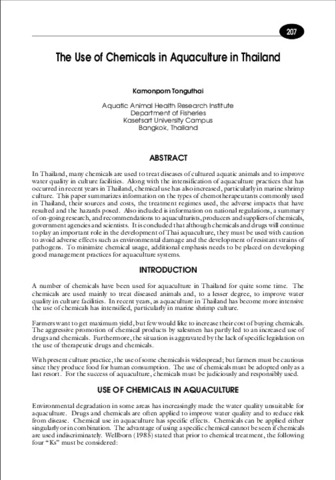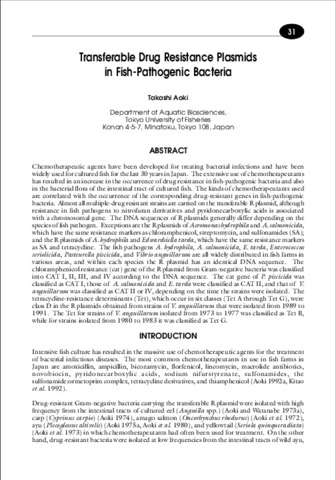The use of chemicals in aquaculture in Thailand
| dc.contributor.author | Tonguthai, Kamonporn | |
| dc.contributor.editor | Arthur, J. Richard | |
| dc.contributor.editor | Lavilla-Pitogo, Celia R. | |
| dc.contributor.editor | Subasinghe, Rohana P. | |
| dc.date.accessioned | 2011-08-27T08:55:00Z | |
| dc.date.available | 2011-08-27T08:55:00Z | |
| dc.date.issued | 2000 | |
| dc.identifier.citation | Tonguthai, K. (2000). The use of chemicals in aquaculture in Thailand. In J. R. Arthur, C. R. Lavilla-Pitogo, & R. P. Subasinghe (Eds.), Use of Chemicals in Aquaculture in Asia: Proceedings of the Meeting on the Use of Chemicals in Aquaculture in Asia, 20-22 May 1996, Tigbauan, Iloilo, Philippines (pp. 207-220). Tigbauan, Iloilo, Philippines: Aquaculture Department, Southeast Asian Fisheries Development Center. | en |
| dc.identifier.isbn | 9718511490 | |
| dc.identifier.uri | http://hdl.handle.net/10862/597 | |
| dc.description.abstract | In Thailand, many chemicals are used to treat diseases of cultured aquatic animals and to improve water quality in culture facilities. Along with the intensification of aquaculture practices that has occurred in recent years in Thailand, chemical use has also increased, particularly in marine shrimp culture. This paper summarizes information on the types of chemotherapeutants commonly used in Thailand, their sources and costs, the treatment regimes used, the adverse impacts that have resulted and the hazards posed. Also included is information on national regulations, a summary of on-going research, and recommendations to aquaculturists, producers and suppliers of chemicals, government agencies and scientists. It is concluded that although chemicals and drugs will continue to play an important role in the development of Thai aquaculture, they must be used with caution to avoid adverse effects such as environmental damage and the development of resistant strains of pathogens. To minimize chemical usage, additional emphasis needs to be placed on developing good management practices for aquaculture systems. | en |
| dc.language.iso | en | en |
| dc.publisher | Aquaculture Department, Southeast Asian Fisheries Development Center | en |
| dc.subject | Penaeidae | en |
| dc.subject | Thailand | en |
| dc.title | The use of chemicals in aquaculture in Thailand | en |
| dc.type | Conference paper | en |
| dc.citation.spage | 207 | |
| dc.citation.epage | 220 | |
| dc.citation.conferenceTitle | Use of Chemicals in Aquaculture in Asia : Proceedings of the Meeting on the Use of Chemicals in Aquaculture in Asia 20-22 May 1996, Tigbauan, Iloilo, Philippines | en |
| dc.subject.asfa | aquaculturists | en |
| dc.subject.asfa | drug resistance | en |
| dc.subject.asfa | chlorine | en |
| dc.subject.asfa | antibiotics | en |
| dc.subject.asfa | zeolites | en |
| dc.subject.asfa | aquaculture | en |
| dc.subject.asfa | hormones | en |
| dc.subject.asfa | feed composition | en |
| dc.subject.asfa | fertilizers | en |
| dc.subject.asfa | disinfectants | en |
| dc.subject.asfa | insecticides | en |
| dc.subject.asfa | aquatic drugs | en |
| dc.subject.asfa | vitamins | en |
| dc.subject.asfa | iodine | en |
| dc.subject.asfa | drugs | en |
| dc.subject.asfa | fish culture | en |
| dc.subject.asfa | policies | en |
| dc.subject.asfa | shrimp culture | en |
| dc.subject.asfa | husbandry diseases | en |
| dc.subject.asfa | environmental impact | en |
| dc.subject.asfa | saponins | en |
| dc.subject.asfa | aquaculture systems | en |
| dc.subject.asfa | control methods | en |
| dc.subject.asfa | hatcheries | en |
| dc.subject.asfa | intensive aquaculture | en |
| dc.subject.asfa | aquaculture development | en |
| dc.subject.asfa | dyes | en |
| dc.subject.asfa | dolomite | en |
| dc.subject.asfa | mariculture | en |
| dc.subject.asfa | vaccines | en |
Files in this item
รายการนี้ปรากฏใน (s)
-
Use of Chemicals in Aquaculture in Asia [19]
Proceedings of the Meeting on the Use of Chemicals in Aquaculture in Asia 20-22 May 1996, Tigbauan, Iloilo, Philippines





